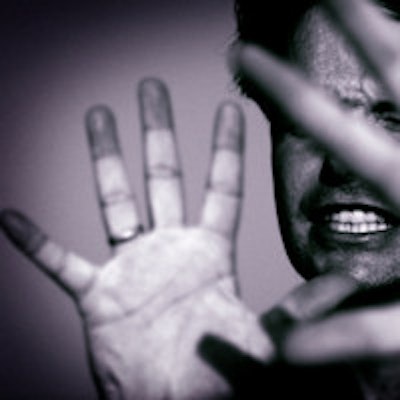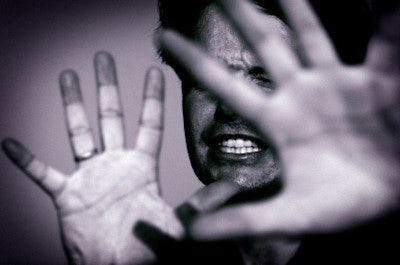
Earlier this year, two radiologists were physically attacked as they worked in their hospital in Belgium. One of them tells Frances Rylands-Monk, associate editor of AuntMinnieEurope.com, about the frightening ordeal, and talks about the lessons for clinical radiologists who are in ever closer contact with patients.
The day had started off like any other. I was steadily working through my morning's reports when my secretary came to tell me that two men were waiting outside to talk to me about an x-ray report I had done. My secretary thought they seemed odd, agitated even. It's not routine, but it's not unusual for me to occasionally discuss images with patients, so I asked her to show them in.
The two Caucasian men entered but refused to sit or take off their gloves, and rejected my offer of a coffee. One of them presented me with a neck x-ray he had undergone three days earlier with a technician and my corresponding report, which stated that the image was "normal." They disagreed with what I had written, were convinced that there was "electric wiring" in the neck cavity, and wanted me to look again and change my report accordingly.
I took a second look, but the x-ray showed nothing strange. I told them I couldn't change the report, as it wouldn't be true. They became angry, moved about my office, shouting and waving their arms, so I got up on the pretext of finding a colleague with whom I could consult about the image. In truth, at that point I felt I needed backup to help me reason with the patient and his companion, and calm them both down. I found another colleague quickly and brought him back to my office. He also looked at the x-ray and told the men we couldn't write about visualizing electrical wire in the neck if it wasn't there.
 Radiologists must be vigilant when they talk to patients, and when they feel at risk, discussion should take place in open spaces..
Radiologists must be vigilant when they talk to patients, and when they feel at risk, discussion should take place in open spaces..
At that point, one of the men said, "You have 10 minutes to change the report, or you will end up like Jesus Christ."
My colleague again refused.
"OK, five minutes," the man insisted.
When my colleague once more told him it wasn't possible, the larger man grabbed him by the neck, pushed him back onto my desk and held him there while the smaller man produced large nails and a hammer from his bag. I ran from my office to find help and was back seconds later, followed by x-ray personnel, and the police were called. By this time, the men had placed a nail on my colleague's hand and had wounded him by partly driving it in, but they ran out when we came in the room, knocking over patients and throwing expensive equipment and computers to the floor as they fled the department. When the police arrived 10 or so minutes later, we were able to provide clear descriptions of the men and identify them from security videos. They were quickly caught in a nearby street and taken into custody.
Get to know your security protocols
The experience left my colleague traumatized and myself shaken. As radiologists, traditionally away from first-line contact with patients, an unprovoked attack such as this was completely unforeseen -- and unprepared for! It struck me that neither I nor my colleague knew the correct protocol for contacting our own hospital security, or at what point this action should have been taken, if indeed such security protocols even existed in the first place.
Radiologists are being encouraged to become increasingly more clinical, involved with patients at each stage of the diagnostic and therapeutic process; therefore, I wonder if such attacks will become more commonplace as they have in accident and emergency units. Either way, it now seems important for hospital personnel, particularly those working in isolated conditions or late at night (including radiology department staff), to know what to do in this particular emergency. For a hospital that theoretically had security procedures in place, and in which corridors are fitted with closed-circuit TV cameras, it is surprising that this incident happened in the first place. On the plus side, the staff across the entire hospital now knows what they should do when threatened.
Following the incident, our hospital management together with the radiologists decided that unless dealing with an elderly or clearly infirm patient who wouldn't be capable of an attack, one-to-one discussion of images should take place in a public space such as the reporting area (in our hospital an open-plan section of the department where other staff are always present), and not in closed spaces such as personal offices. Second, radiology staff working at night, early in the mornings, or late evenings were issued with special telephones that included a "panic button" that would immediately summon hospital security in dangerous situations.
'Delusional and paranoid'
The police psychologist who evaluated our assailants in custody told us later the men were highly intelligent but delusional and paranoid. They had thought Belgian Intelligence had planted wires in one of them for surveillance purposes, and our "refusal to see" these wires on the x-ray meant we were evidently part of the conspiracy. They were committed to a secure hospital for treatment for an indefinite amount of time.
In a way, we were lucky this incident happened during the middle of the day and not at night when there would have been nobody at hand to call. We were also "lucky" that our attackers were carrying a hammer and nails, rather than a knife or a gun. The police were convinced that had this been the case, we would be dead men.
Radiology departments aren't the closed impenetrable places they once appeared to be. It is good to be patient-focused, but with this comes an element of risk. Radiologists must be vigilant when they talk to patients. With those whom radiologists feel at risk, discussion should take place in open spaces, while maintaining a degree of privacy where possible. Both management and staff should ensure security protocols aren't just known in theory, but that they work in practice and that drills are taken seriously. A panic button phone system is a good idea for any hospital, but even without such a mechanism, radiologists should know their hospital's protocol: who to call, how, and when.



















